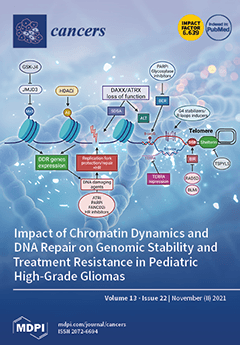The prognosis of
BRAFV600E-mutant papillary thyroid carcinoma (PTC) ranges from indolent to highly aggressive courses. To better define the genetic diversity of this subtype, we evaluated the survival according to the presence of an additional mutation in genes encoding functional groups (FGs) in
BRAFV600E-mutant advanced PTC patients. Targeted next-generation sequencing was performed in primary tumors of 50
BRAFV600E-mutant PTCs with distant metastasis or aggressive variants. The mutation in genes encoding FGs included alterations in histone methyltransferases, SWI/SNF subunit, and the PI3K/AKT/mTOR pathway. The primary outcome was overall survival (OS). Fifteen patients only had the
BRAFV600E-mutation (group 1), 22 had
BRAFV600E and mutation other than FGs (group 2), and 13 had
BRAFV600E and FG mutation (group 3). OS was significantly lower in patients with FG mutations (
p = 0.001) than those without, and group 3 patients had the worst survival (
p = 0.004). OS significantly varied among none, one, or two FG mutation sites (
p = 0.005). Presence of FG mutation was independently associated with increased mortality (hazard ratio 11.65, 95% confidence interval 1.39–97.58,
p = 0.024). Coexistence of mutations in
BRAFV600E and genes encoding FGs was associated with high mortality. Identification of FG mutation in
BRAFV600E-mutant PTCs may be valuable in risk stratifying this subtype.
Full article






